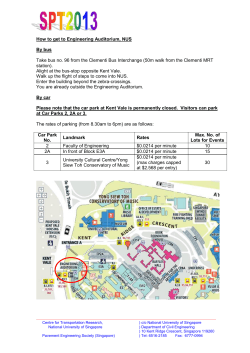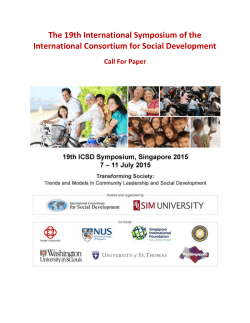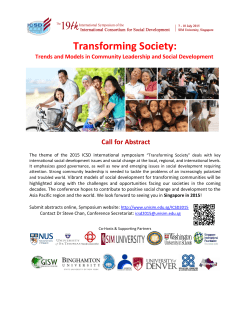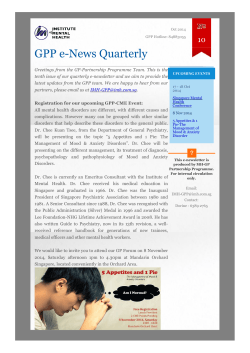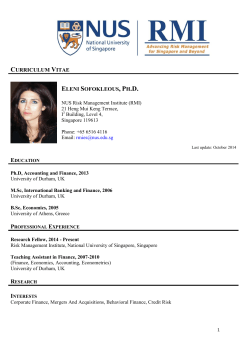
Document 418842
Welcome Message Welcome Message from the General Chairs On behalf of the Organizing Committee, it is our greatest pleasure to welcome you to the 5th International Conference on Computational Systems-Biology and Bioinformatics (CSBio2014). The conference runs from 10th to 12th November 2014 at Nanyang Technological University, which is a global university on a rapid rise with sustainable research, and it is the worlds biggest engineering university. The conference venue, Nanyang Executive Centre, is located in the Yunnan Garden Campus of Nanyang Technological University, offering a premier venue for various events. This years conference is jointly organised by Nanyang Technological University, National University of Singapore, Agency for Science, Technology and Research and King Mongkut’s University of Technology Thonburi, and we continue the good practice of collocating with IES2014. The CSBio brings together researchers and practitioners to meet at this event to exchange ideas and stimulate research collaborations as a result of rapid advances in the generation of high-throughput ”omics” data (such as deep sequencing). To extract biological knowledge from the data, and translate it into benefits for society (e.g. better medicine and healthcare), novel computational tools and insights are needed for data analysis and building models. We are keeping to the tradition in carefully selecting a handful of high-quality papers from many countries. These will be recommended for journal publications to the Journal of Bioinformatics and Computational Biology (JBCB) or the Journal of Medical Imaging and Health Informatics (JMIHI). This year we are very privilege to have Prof Ng Huck Hui, executive director of Genome Institute of Singapore, to deliver his keynote titled Systems Biology of Stem Cells. A series of social functions have been planned, which include a welcome reception, lunches, conference banquet at Faber Peak Singapore, and tours to the Singapore Cable Car as well as Garden by the Bay. These social activities serve as a good channel to establish new connections and foster everlasting friendship among fellow counterparts. Last but not least, we would like to express our sincere gratitude to everyone involved in making the conference a success. Many thanks go to advisory board members, the organizing committees, the keynote and plenary speakers, the guest editors Prof (adj) Li Xiaoli, Prof Zheng Jie, and Prof Chou Siaw Meng for the two journals (JCBC and JMIHI), the program committee and reviewers, many of whom are active reviewers for the above journals, the conference participants, and of course, to all the contributing authors who will be sharing the interesting results of their research. With our best wishes for a wonderful and stimulating stay in Singapore! Conference Committee Conference Committee General Chair Kwoh Chee Keong, Singapore. ASCKKWOH@ntu.edu.sg General Co-Chair Jonathan H. Chan, Thailand. jonathan@sit.kmutt.ac.th Program Chair Li Xiaoli, Singapore. xlli@i2r.a-star.edu.sg Program Co-Chair Zheng Jie, Singapore. ZHENGJIE@ntu.edu.sg Program Co-Chair Chou Siaw Meng, Singapore. MSMCHOU@ntu.edu.sg Registration Chair Huanjin Tang, Singapore. htang@i2r.a-star.edu.sg Publicity Chair Wu Min, Singapore. wumin@i2r.a-star.edu.sg Local Arrangements Chair Qi Cao, Singapore. Secretary Worrawat Engchuan, Thailand. Conference Venue and Transportation International Advisory Board David W. Ussery Oak Ridge National Lab, USA Jens B. Nielsen Chalmers University of Technology, Sweden Bairong Shen Soochow University, China Kwong-Sak Leung Chinese University of Hong Kong, Hong Kong Nikola Kasabov Auckland University of Technology, New Zealand Nikhil R. Pal Indian Statistical Institute, India Richard Wintle The Centre for Applied Genomics, Canada Sissades Tongsima National Center for Genetic Engineering and Biotechnology, Thailand Stephen Wong Houston Methodist Research Institute, USA Sung-Bae Cho Yonsei University, South Korea Supapon Cheevadhanarak King Mongkut’s University of Technology Thonburi, Thailand Kay Chen Tan National University of Singapore, Singapore Tom Lenaerts Universit libre de Bruxelles, Belgium Yaochu Jin University of Surrey, UK Ong Yew Soon Nanyang Technological University, Singapore Conference Venue and Transportation PC members Shandar Ahmad National Institute of Biomedical Innovation, Japan Tatsuya Akutsu Kyoto University, Japan Shunsuke Aoki Kyushu Institute of Technology, Japan Jonathan Chan King Mongkut’s University of Technology Thonburi, Thailand Xin Chen Nanyang Technological University, Singapore Jin Chen Michigan State University, USA Jean-Paul Comet University of Nice Sophia Antipolis, France Frank Eisenhaber Bioinformatics Institute, A*STAR, Singapore Worrawat Engchuan King Mongkut’s University of Technology Thonburi, Thailand Ge Gao Peking University, China Ivo Grosse Martin Luther University of Halle-Wittenberg, Genmany Chia-Lang Hsu National Taiwan University, Taiwan Hsuan-Cheng Huang National Yang Ming University, Taiwan Yaochu Jin University of Surrey, UK Tamer Kahveci University of Florida, USA Saowalak Kalapanulak Bioinformatics and Systems biology Program, Thailand Asif M. Khan National University of Singapore, Singapore Tsung Fei Khang University of Malaya, Malaysia Daisuke Kihara Purdue University, USA Jaebum Kim Konkuk University, Korea Sun Kim National Institue of Health, USA Yoo-Ah Kim National Institue of Health, USA Kengo Kinoshita Tohoku University, Japan Akihiko Konagaya Tokyo Institute of Technology, Japan Bartosz Krawczyk Wroclaw University Of Technology, Poland Igor Kurochkin Bioinformatics Institute, A*STAR, Singapore Conference Venue and Transportation Chee-Keong Kwoh Nanyang Technological University, Singapore Teeraphan Laomettachit King Mongkut’s University of Technology Thonburi, Thailand Hyunju Lee Gwangju Institute of Science and Technology, Korea Jeongjin Lee Soongsil University, Korea Tom Lenaerts Universit libre de Bruxelles, Belgium Jinyan Li University of Technology, Sydney, Australia Xiaoli Li Institute for Infocomm Research, A*STAR, Singapore C P Lim Deakin University, Australia Fenglou Mao University of Georgia, USA Osamu Maruyama Kyushu University, Japan Sebastian Maurer-Stroh A*STAR, Singapore Asawin Meechai King Mongkut’s University of Technology Thonburi, Thailand Niranjan Nagarajan Bioinformatics Institute, A*STAR, Singapore Jin-Wu Nam Hanyang University, Korea Somnuk Phon-Amnuaisuk Institut Teknologi Brunei, Brunei Treenut Saithong King Mongkut’s University of Technology Thonburi, Thailand Yasubumi Sakakibara Keio University, Japan Christian Schnbach Nazarbayev University, Republic of Kazakhstan Kumar Selvarajoo Keio University, Japan Bairong Shen Soochow University, China Soo-Yong Shin Asan Medical Center, Korea Kyung-Ah Sohn Ajou University, Korea Chuan-Kang Ting National Chung Cheng University, Taiwan Wanwipa Vongsangnak Soochow University, Thailand Lusheng Wang City University of Hong Kong, Hong Kong Min Wu A*STAR, Singapore Xuegong Zhang Tsinghua University, China Shihua Zhang University of Southern Canlifornia, China Yun Zheng Fudan University, China Jie Zheng Nanyang Technological University, Singapore Shuigeng Zhou Fudan University, China Shanfeng Zhu Fudan University, China Zexuan Zhu Shenzhen University, China Conference Venue and Transportation Conference Venue and Transportation The Nanyang Executive Centre is the home of NTUs Executive Programmes and continuing education. It provides an excellent environment away from the city and distractions of the office for executive learning. The 170 guestrooms and suites have been designed to meet the needs of both training executives and business travellers.All the guestrooms are equippedwith awork area and othermodern amenities to ensure they provide guests with a pleasant stay. Complimentary Wi-Fi is available to all guests in their rooms, lobby and function spaces. Further, facilities such as swimming pool, gym, football field, basketball court, etc., are available around NEC. Nanyang Executive Centre (General enquiries) 60 Nanyang View, Singapore, 639673. Tel: +65 6790 6699/ 6790 6697 Email: ntu-nec@ntu.edu.sg http: // www. ntu. edu. sg/ nec/ virtualTour/ Pages/ VirtualTour. aspx . Nanyang Executive Centre Conference Venue and Transportation Map of Nanyang Executive Centre Conference Venue and Transportation Transportation form Singapore Changi Airport to Nanyang Executive Centre Walk from Hall 8 to Nanyang Executive Centre Keynote Speaker Keynote Speech: Systems Biology of Stem Cells Professor Huck-Hui NG Genome Institute of Singapore nghh@gis.a-star.edu.sg Date/Time: 08:30 – 09:30, Tuesday, 11 Nov. 2014 Venue: Auditorium, NTU Biosketch of the Speaker Professor Huck-Hui NG is the Executive Director of the Genome Institute of Singapore. The Genome Institute of Singapore was started as a national flagship programme to tap into the innovation and impact of deciphering the genetic blueprint of mankind. Today, it houses more than 200 researchers working on different aspects of Human Genomics (Human Genetics, Infectious Diseases, Cancer Therapeutics and Stratified Oncology, Stem Cell Genomics, Cancer Stem Cell Genomics, Translational Genomics, Computational and Systems Biology). Huck-Hui NG graduated from the National University of Singapore with a first class Honor degree in Molecular and Cell Biology and obtained his PhD from the University of Edinburgh. He spent the next few years working at the Harvard Medical School as a Damon Runyon-Walter Winchell research fellow. Upon return to Singapore, he started his research programme on Stem Cell Genomics at the Genome Institute of Singapore. His lab works on different aspects of Systems Biology of Stem Cells. Specifically, his group uses genome wide approaches to dissect the transcriptional regulatory networks in embryonic stem cells with the aim to identify key nodes in this network. This had led to the first paper on the whole genome and unbiased mapping of key transcription factors in mouse embryonic stem cells. His group also conducted the whole genome genetic screen for human embryonic stem cells. More recently, his lab has begun to investigate the reprogramming code behind the induction of pluripotency in somatic cells. Huck-Hui Ngs works have been published in journals such as Cell, Science and Nature. He also sits on the Editorial Board of International Journals such as Genes & Development. His papers have received over 12,000 citations and his H-index is 44. His research work has earned him several prestigious national and international accolades including the Singapore Youth Award (2005 and 2010), the National Science Award 2007, the HUGO Chens New Investigator Award 2010 and the Presidents Science Award 2011. Huck-Hui NG holds Adjunct Professor appointment at the National University of Singapore (Departments of Biochemistry and Biological Sciences) and the Nanyang Technological University (School of Biological Sciences). He is also the President of the Stem Cell Society, Singapore. Keynote Speaker Abstract Embryonic stem (ES) cells are characterized by their ability to self-renew and remain pluripotent. Transcription factors have critical roles in the maintenance of ES cells through specifying an ES-cell-specific gene expression program. Deciphering the transcriptional regulatory network that describes the specific interactions of these transcription factors with the genomic template is crucial for understanding the design and key components of this network. To gain insights into the transcriptional regulatory networks in ES cells, we use chromatin immunoprecipitation coupled to ultra-high-throughput DNA sequencing (ChIP-seq) to map the locations of sequence specific transcription factors. These factors are known to play different roles in ES cell biology. Our study provides new insights into the integration of these regulators to the ES cell-specific transcription circuitries. Collectively, the mapping of transcription factor binding sites identifies new features of the transcriptional regulatory networks that define ES cell identity. Using this knowledge, we investigate nodes in the network which when activated, will jump-start the ES cell-specific expression program in somatic cells. Technical Programme Technical Programme Technical Programme – Day 1: Tuesday, 11 Nov. 2014 08:00 onwards Registration 08:15 – 08:30 Opening of CSBio 08:30 – 09:30 CSBio Keynote: Systems Biology of Stem Cells by Professor Huck-Hui NG, Genome Institute of Singapore Venue Auditorium, NTU 10:30 – 11:00 Coffee Break 12:00 – 13:00 Lunch Break Session Interaction, Biological Network and Pathway Time 13:00 – 15:00 Venue Auditorium, NTU Chair Kumar Selvarajoo 13:00 – 13:20 Invited Speech: Emergent Properties in Cell Signaling and Transcriptome-wide Response Kumar Selvarajoo 13:20 – 13:40 Investigating noise tolerance in an efficient engine for inferring biological regulatory networks. Asako Komori, Yukihiro Maki, Isao Ono and Masahiro Okamoto. 13:40 – 14:00 Predicting Essential Genes and Synthetic Lethality via Influence Propagation in Signaling Pathways of Cancer Cell Fates. Fan Zhang, Min Wu, Xuejuan Li, Xiaoli Li, Chee Keong Kwoh and Jie Zheng. 14:00 – 14:20 Computationally Predicting Protein-RNA Interactions Using Only Positive and Unlabeled Examples. Zhanzhan Cheng, Shuigeng Zhou and Jihong Guan. Technical Programme 14:20 – 14:40 Network Reconstruction vs. Edge Enrichment: Which is Better in Protein Function Prediction Based on Protein-Protein Interaction Networks? Wei Xiong, Luyu Xie, Jihong Guan and Shuigeng Zhou. 14:40 – 15:00 Detection of Highly Overlapping Communities in Complex Networks. Madhusudan Paul, Rishav Anand and Ashish Anand. 15:00 – 15:30 Coffee Break Session Medical Data Diagnosis, Classification and Simulation Time 15:30 – 17:30 Venue Auditorium, NTU Chair Shirley Sue 15:30 – 15:50 Microarray-based cancer diagnosis using an integrative gene-set analysis approach. Worrawat Engchuan, Asawin Meechai, Sissades Tongsima and Jonathan Chan. 15:50 – 16:10 Comparison of Different ROI Sizes for Breast Density Classification: An Experimental Study. Vipul Sharma and Sukhwinder Singh. 16:10 – 16:30 Real-time Analysis of Vital Signs Using Incremental Data Stream Mining Techniques with a Case Study of ARDS under ICU Treatment. Simon Fong, Shirley Siu, Suzy Zhou, Jonathan Chan, Sabah Mohammed and Jinan Fiaidhi. 16:30 – 16:50 Numerical Simulation of Contaminant Control in Multi-patient Intensive Care Unit of Hospital Using Computational Fluid Dynamics. Tikendra Nath Verma and Shobha Lata Sinha. 16:50 – 17:10 Efficient Variation-based Feature Selection for Medical Data Classification. Simon Fong, Justin Liang, Shirley Siu and Jonathan Chan. 17:10 – 17:30 Docking Score Calculation Using Machine Learning with an Enhanced Inhibitor Database. Masato Okada, Hayato Ohwada and Shin Aoki. 17:40 – 21:00 Award Banquet Technical Programme Technical Programme – Day 2: Wednesday, 12 Nov. 2014 Session Sequence, Structure and Parallel Computing Time 08:20 – 10:40 Venue Auditorium, NTU Chair TBA 08:20 – 08:40 FQC: a novel approach for efficient compression, archival and dissemination of fastq datasets. Anirban Dutta, Mohammed Monzoorul Haque, Tungadri Bose, Cvsk Reddy and Sharmila Mande. 08:40 – 09:00 Grid-assembly: an oligo-nucleotide composition based partitioning strategy to aid metagenomic sequence assembly. Tarini Shankar Ghosh, Varun Mehra and Sharmila S Mande. 09:00 – 09:20 PSOVINA: the hybrid particle swarm optimization algorithm for protein-ligand docking. Marcus C. K. Ng, Simon Fong and Shirley W. I. Siu. 09:20 – 09:40 Identifying SNP-SNP interactions with CNAs in lymphoma susceptibility. Tse-Yi Wang, Yen-Ho Chen and Kuang-Chi Chen. 09:40 – 10:00 PARALLELFRAPPE: parallel version of admixture calculation. Alongkot Burutarchanai and Prabhas Chongstitvatana. 10:00 – 10:20 Massively Parallel Tool for Protein Structure Comparison. Ahmad Salah, Kenli Li and Tarek Gharib. 10:20 – 10:40 Embedding Assisted Prediction Architecture for Event Trigger Identification. Yifan Nie, Wenge Rong, Yiyuan Zhang, Yuanxin Ouyang and Zhang Xiong. 10:40 – 11:00 Coffee Break 13:00 – 14:00 Lunch Break 14:00 – 18:00 Free Tour Abstracts Abstracts Day 1: Tuesday, 11 Nov. 2014 Session Time Venue Chair Interaction, Biological Network and Pathway 13:00 – 15:00 Auditorium, NTU Kumar Selvarajoo 13:00 – 13:20 Invited Speech: Emergent Properties in Cell Signaling and Transcriptomewide Response a cell is increased. This resulted in deterministic cellular response that can be modeled using linear response rules. Adopting the rules, we have successfully predicted and experimentally verified novel signaling features, such as missing intermediates and crosstalk mechanisms, and have identified novel targets for controlling proinflammatory response and cancer apoptosis. Specifically, I will provide an overview on toll-like receptors, tumor necrosis factor (TNF) receptor, and TNF-related apoptosis-inducing ligand receptor signaling. I will also show RNA-Seq based single cell transcriptome-wide data analysis for embryonic developmental process (from oocyte to ES cell stage). Kumar Selvarajoo1,a 13:20 – 13:40 Investigating noise tolerance in an efficient engine for inferring biological regThe recent surge in systems biology efforts is reveal- ulatory networks 1 Institute for Advanced Biosciences Keio University, Japan E-mail: a kumar@ttck.keio.ac.jp ing many complexities that cannot be understood using traditional causal relationship approaches. For example, gene expressions between identical single cells are shown to be stochastic in time, and clonal population of cells display heterogeneity in the abundance of a given protein per cell at any measured time. Despite this, at population level, cells are able to execute well-defined biological processes such as growth, division, differentiation and immune response. How do living systems overcome single cell fluctuations to produce deterministic population response? Our research focuses on fundamental cell behaviors. We investigate the dynamic instructive cell signaling and highthroughput transcriptome-wide behaviors of immune, cancer and embryonic development cells, from single cells to population scale. As a general feature, we have found that single cell fluctuations reduce when cells form ensembles, due to the reduction of dominant stochastic and transcriptomewide noise as the number of cells or molecules within Asako Komori1,a , Yukihiro Maki2,c , Isao Ono3,d and Masahiro Okamoto1,2,b 1 Department of Bioinformatics, Graduate School of Systems Life Sciences, Kyushu University Fukuoka, 8128582, Japan 2 Advanced Research Center for Synthetic Systems Biology, Kyushu University Fukuoka, 8128582, Japan 3 Graduate School of Computational Intelligence and Systems Science, Tokyo Institute of Technology Tokyo, 2268502, Japan a E-mail: a-komori, b okahon@brs.kyushu-u.ac.jp, c ykhrmaki@tos.bbiq.jp, d isao@dis.titech.ac.jp Biological systems are composed of biomolecules such as genes, proteins, metabolites, and signaling components, which interact in complex networks. To understand complex biological systems, it is important to be capable of inferring regulatory networks from experimental time series data. In previous studies, we Abstracts developed efficient numerical optimization methods for inferring these networks, but we have yet to test the performance of our methods when considering the error (noise) that is inherent in experimental data. In this study, we investigated the noise tolerance of our proposed inferring engine. We prepared the noise data using the Langevin equation, and compared the performance of our method with that of alternative optimization methods. ways to simulate the influence of single gene knockdown and double genes knock-down to cell death. A pair of genes is considered as an SL candidate when double knock-down increases the probability of cell death significantly, but single knock-down does not. The single gene knock-down is confirmed according to the human essential genes database. Our validation against literatures shows that the predicted SL candidates agree well with wet-lab experiments. A few novel reliable SL candidates are also predicted Keywords: S-system formalism; real-coded genetic by our model. algorithm; gene regulatory networks; systems biology; system identification. Keywords: Synthetic Lethality; Signaling Pathways; Data-driven. 13:40 – 14:00 Predicting Essential Genes and Synthetic Lethality via Influence Propagation in Signaling Pathways of Cancer Cell Fates 14:00 – 14:20 Computationally Predicting ProteinRNA Interactions Using Only Positive and Unlabeled Examples Fan Zhang1,a , Min Wu2,e , Xuejuan Li1,b , Xiaoli Li2,f , Zhanzhan Cheng1,a , Shuigeng Zhou1,b and Jihong Chee Keong Kwoh1,c , Jie Zheng1,3,d Guan2,c 1 1 A major goal of personalized anti-cancer therapy is to increase the drug efects while reducing the side-efects as much as possible. A novel therapeutic strategy called synthetic lethality (SL) provides a great opportunity to achieve this goal. SL arises if mutations of both genes lead to cell death while mutation of either single gene does not. Hence, the SL partner of a gene mutated only in cancer cells could be a promising drug target, and the identification of SL pairs of genes is of great significance in pharmaceutical industry. In this paper, we propose a hybridized method to predict SL pairs of genes. We combine a data-driven model with knowledge of signalling path- Protein-RNA interactions (PRIs) are considerably important in a wide variety of cellular processes, ranging from transcriptional and post-transcriptional regulations of gene expression to the active defense of host against virus. With the development of high throughput technology, large amounts of proteinRNA interaction information is available for computationally predicting unknown PRIs. In recent years, a number of computational methods for predicting PRIs have been developed in the literature, which usually artificially construct negative samples based on verified non-redundant datasets of PRIs to train classifiers. However, such negative samples are not real negative samples, some even may be un- School of Computer Engineering, Nanyang Technological University, Singapore 639798 2 Data Analytic Department, Institute for Infocomm Research, A*STAR, Singapore 138632 3 Genome Institute of Singapore, A*STAR, Singapore 138672 E-mail: a fzhang005@e.ntu.edu.sg, b lixj, c asckkowh, d e f zhengjie@ntu.edu.sg, wumin, xlli@i2r.astar.edu.sg Shanghai Key Lab of Intelligent Information Processing, and School of Computer Science Fudan University, 220 Handan Road, Shanghai 200433, China 2 Department of Computer Science and Technology Tongji University, 4800 Cao’an Road, Shanghai 201804, China a E-mail: zhanzhancheng, b sgzhou@fudan.edu.cn, c jhguan@tongji.edu.cn Abstracts known positive samples. Consequently, the classifiers PPI networks have been proposed for protein functrained with such training datasets can not achieve tion prediction. Unfortunately, these PPI networks satisfactory prediction performance. face serious data quality challenges of false positives (noise) and false negatives (incompleteness), which In this paper, we propose a novel method PRIPU that adversely affects the performance of protein function employs biased-SVM for predicting Protein-RNA Inprediction. teractions using only Positive and Unlabeled examples. To the best of our knowledge, this is the first Methodology: To boost the performance of protein work that predicts PRIs using only positive and un- function prediction based on PPI networks, two malabeled samples. We first collect known PRIs as our jor types of approaches were proposed to construct benchmark datasets and extract sequence-based fea- more robust and reliable PPI networks, including nettures to represent each PRI. To reduce the dimen- work reconstruction and edge enrichment. Although sion of feature vectors for lowering computational various implementations of these two types of apcost, we select a subset of features by a filter-based proaches were reported, and definite performance imfeature selection method. Then, biased-SVM is em- provements were achieved, there lacks a systematic ployed to train prediction models with different PRI performance comparison between these two types of datasets. To evaluate the new method, we propose a approaches. To answer this question, in this paper we new performance measure called explicit positive re- carry out a comprehensive performance comparison call (EPR), which is specifically suitable for the task of these two types of approaches. Concretely, we first of learning positive and unlabeled data. reconstruct and enrich PPI networks by using protein sequence similarity, local similarity indices and Experimental results over three datasets show that global similarity indices, and then compare the preour method not only outperforms four existing methdiction performance of these reconstructed and enods, but also is able to predict unknown PRIs. riched networks with that of the original networks of Keywords: Protein-RNA Interactions; Biased-SVM; two real PPI datasets. Prediction. Conclusions: Experimental results demonstrate that the enriched networks achieves more accurate predictions than the original networks and the recon14:20 – 14:40 Network Reconstruction vs. Edge En- structed networks. Meanwhile, the reconstructed network performs better than the original network richment: Which is Better in Protein of the BioGRID dataset that contains only physical Function Prediction Based on Protein- interactions. However, the original network of the Protein Interaction Networks? STRING dataset that contains known and predicted interactions outperforms the reconstructed network. Wei Xiong1 , Luyu Xie1 , Jihong Guan2 and Shuigeng This means that network reconstruction is more effecZhou1,a tive in relatively small and incomplete PPI networks. Our empirical study also validates that sequence sim1 School of Computer Science, and Shanghai Key Lab ilarity is more effective than global similarity and loof Intelligent Information Processing, Fudan Univercal similarity in PPI network enrichment. sity, Shanghai, China 1 Department of Computer Science & Technology, Tongji University, Shanghai, China E-mail: a sgzhou@fudan.edu.cn Background: The high-throughput technologies have led to vast amounts of protein-protein interaction (PPI) data, and a number of approaches based on Abstracts 14:40 – 15:00 Detection of Highly Overlapping Communities in Complex Networks Session Date/Time Venue Chair Madhusudan Paul1,a , Rishav Anand1,b and Ashish Anand1,c Medical Data Diagnosis, Classi– –fication and Simulation 15:30 – 17:30 Auditorium, NTU Shirley Sue 1 Department of Computer Science and Engineering Indian Institute of Technology Guwahati, India E-mail: a madhusudan, b anand.ashish@iitg.ernet.in, c rishav@alumni.iitg.ernet.in 15:30 – 15:50 Microarray-based cancer diagnosis usDetecting communities in complex networks is one of ing an integrative gene-set analysis apthe most important aspects to understand complex proach systems. In reality, many of these communities are highly overlapping in nature, i.e., several nodes belong to more than three communities. Identification of highly overlapping communities are strongly demanded in many applications such as systems biology and social networks. Although there are algorithms for detecting overlapping communities, majority of these are unable to detect highly overlapping communities properly. The performance of these algorithms falls sharply when overlapping nodes belong to more than three communities. In this paper, we propose an extension of existing overlapping community detection algorithm, namely Greedy Clique Expansion (GCE). Due to lack of unavailability of real networks with complete information of ground-truth communities, firstly, we experiment on state-of-the-art synthetic benchmark datasets and observe that our proposed extension exhibits better performance when overlapping nodes belong to more than three communities. We also experiment on real datasets and observe competitive performance. The proposed extension can be applied on networks with highly overlapping community structure such as protein-protein interaction networks. Keywords: Overlapping community detection; Greedy Clique Expansion; complex net- works. 15:00 – 15:30: Coffee Break Worrawat Engchuan1,a , Asawin Meechai2,b , Sissades Tongsima3,c and Jonathan Chan1,d 1 Data and Knowledge Engineering Laboratory, School of Information Technology King Mongkuts University of Technology Thonburi, Bangkok, Thailand 2 Department of Chemical Engineering, Faculty of Engineering King Mongkuts University of Technology Thonburi, Bangkok, Thailand 3 Biostatistics and Informatics Laboratory, Genome Institute National Center for Genetic Engineering and Biotechnology a E-mail: worrawat.eng@st.sit.kmutt.ac.th, b c asawin.mee@kmutt.ac.th, sissades@biotec.or.th, d jonathan@sit.kmutt.ac.th Cancer is a complex disease that cannot be diagnosed reliably using only single gene expression analysis. Hence it is fast becoming the norm to do gene-set analysis instead. This work provides a tool (Pathway Activity Toolbox: PAT) that incorporates three geneset analysis methods, namely ANOVA-based feature set (AFS), Negatively Correlated Feature Set (NCFSi) and Conditional-Responsive gene (CORG)-based. These methods identify subsets of phenotype-relevant genes, which will be used to transform the gene expression levels to gene-set activities. As a case study, the classifications using the expression levels of these gene subsets without transformation and the geneset activities are compared in terms of the performance for disease diagnosis of three common cancer Abstracts types. Additionally, several gene-set collections and classifiers can be optimally chosen for each disease. We demonstrate the performance of PAT by running it using three gene-set collections from MSigDB and three traditional classifiers on eight actual microarray datasets of lung, colorectal and breast cancers. Five-by-Two-fold cross-validation is used for parameters optimization and the overall classification performance is evaluated by cross dataset validation. The comparison results show that the selections of gene-set analysis methods, gene-set collections, and classifiers can be made differently depending on the disease. The results show that the use of Gene-SetAnalysis (GSA)-based gene markers is preferred to gene-set activity markers for disease diagnosis. PAT can be accessed via http://pat.sit.kmutt.ac.th from which its java library for gene-set analysis, simple classification and a database with eight benchmark datasets of three cancers can be downloaded. uated in terms of the performance of differentiating between the fatty and dense breast tissue. From the experimental results it has been found that ROI of size 200200 pixels results in maximum overall accuracy of 97.2% with 100% sensitivity. The experimental results encourage the use of 200200 pixels ROI for classification of breast density. Keywords: Region of Interest; Breast Density; Classification; Texture Features; Feature Selection. 16:10 – 16:30 Real-time Analysis of Vital Signs Using Incremental Data Stream Mining Techniques with a Case Study of ARDS under ICU Treatment Simon Fong1,a , Shirley Siu1,b , Suzy Zhou2,c , Jonathan Chan3,d , Sabah Mohammed4,e and Jinan Keywords: Microarray; Gene expression analysis; Fiaidhi4,f Gene set; Classification; Feature selection; Breast 1 cancer; Lung cancer; Colorectal cancer. Department of Computer and Information Science University of Macau Macau SAR 2 Department of Products Management Mozat Pte 15:50 – 16:10 Ltd Singapore Comparison of Different ROI Sizes for 3 School of Information Technology King Mongkut’s Breast Density Classification: An Ex- University of Technology Thonburi Bangkok, Thailand perimental Study 4 Department of Computer Science Lakehead University Thunder Bay, Canada Vipul Sharma1,a and Sukhwinder Singh1,b a b E-mail: ccfong, shirley.siu@umac.mo, 1 c d UIET, Panjab University, Sector-25 Chandigarh, suzyzhou@mozat.com, jonathan@sit.kmutt.ac.th, e 160014, INDIA sabah.mohammed, f jinan.fiaidhi@lakeheadu.ca a b E-mail: vipuls85@gmail.com, sukhdalip@pu.ac.in Analysing data streams of vital signs has been a In this paper, an experimental study has been done to popular topic in research communities with techfind the optimal size of Region of Interest (ROI) for niques mainly of detection, classification and predicthe classification of breast density. ROI is a subpart tion. One drawback for data classification/prediction of the image that contains very important informa- is that the data mining model is built based on a tion related to the diagnosis. Since an ROI is used as full set of stationary data. Updating the model for representative of the image, and all further computa- sustaining the classification accuracy often needs the tions and diagnosis depends upon the ROI, therefore, whole dataset including the evolving data to be acit is very crucial to select an appropriate image area cessed. This nature of model rebuilding dampers the as ROI. For this purpose, different sized ROIs are possibility of mining vital signs in real-time and at selected from mammogram in such a way that their high speed. Unfortunately all the past papers in central pixel is same. The effect of ROI size is eval- the literature were based on traditional data mining Abstracts models. In this paper, a data stream mining model which is flexible in configuring with different incremental data stream learning methods is tested as the real-time classification engine for mining vital data streams. A computer simulation experiment is conducted that is based on a case study of adult respiratory distress syndrome under twelve-hours of ICU treatment. The results indicate promising possibilities of performing real-time prediction by the proposed model. Keywords: Vital Signs Analysis, Data Stream Mining, Naviie Bayes, Support Vector Machine, Optimized Very Fast Decision Tree. from the patient to the other people in the ICU of hospital. A healthy environment can be achieved by minimizing the risk of contamination through appropriate filtration and air distribution scheme. It is observed that stagnant zone near the doctor and patient is not healthy. Therefore suitable ventilation arrangement and position of patient (bed) must be provided for healthy environment in the ICU. Keywords: Numerical simulation; ICU; Contaminant particle; Lagrangian model. 16:50 – 17:10 Efficient Variation-based Feature Selection for Medical Data Classification 16:30 – 16:50 Numerical Simulation of Contaminant Simon Fong1,a , Justin Liang1 , Shirley Siu1 and Control in Multi-patient Intensive Care Jonathan Chan2,b Unit of Hospital Using Computational 1 Department of Computer and Information Science, Fluid Dynamics Tikendra Nath Verma1,a and Shobha Lata Sinha1,b 1 National Institute of Technology Raipur, Department of Mechanical Engineering, Raipur, Chhattisgarh 492010, India a E-mail: verma tikendra@yahoo.co.in, b shobha sinha1@rediffmail.com The complex hospital environment requires special attention to ensure healthy indoor air quality (IAQ). It is necessary to protect to patient and healthcare workers against hospital acquired pathogens/infections. A CFD analysis supported by measurement data has been carried out to simulate the temperature distribution, air flow pattern in the ICU and the contaminant dispersion from the patient. Numerical model solves conservation of mass, momentum and energy equations. The contaminated particle (infection) which is simulated with a Lagrangian particle tracking model and the same has been carried out by simulation. CFD analysis is used to simulate and compare the removal of contaminated particle using a number of different ventilation systems. The study concerns about the health risk of the airborne diseases (bacteria, fungus, viruses etc.) University of Macau Taipa, Macau SAR 2 School of Information Technology, King Mongkut’s University of Technology Thonburi Bangkok, Thailand b E-mail: jonathan@sit.kmutt.ac.th, a ccfong@umac.mo Medical data which collected from sophisticated and sometimes different instruments are described by a large number of feature variables and a historical archive of patients records, known as multivariate medical dataset. In biomedical data mining, classification model is often built upon such dataset for predicting which particular type of disease that a new instance of record belongs to. One of the challenges in inferring a classification model with good prediction accuracy is to select the relevant features that contribute to maximum predictive power. Many feature selection techniques have been proposed and studied in the past, but none so far claimed to be the best. In this paper, a novel and efficient feature selection method called Clustering Coefficients of Variation (CCV) is proposed. CCV is based on a very simple principle of variance-basis which finds an optimal balance between generalization and overfitting. Through a computer simulation experiment, Abstracts eight medical datasets with substantially large number of features are tested by CCV in comparison to three popular feature selection techniques. Results show that CCV outperformed them in all aspects of averaged performances and speed. By the simplicity of design it is anticipated that CCV will be a useful alternative of feature selection method for tasks of medical data classification especially with those datasets that are characterized by many features. Keywords: Feature selection; Classification; Medical datasets. 17:10 – 17:30 Docking Score Calculation Using Machine Learning with an Enhanced Inhibitor Database Masato Okada1,a , Hayato Ohwada1,b and Shin Aoki1,c 1 Faculty of Science and Technology, Tokyo University of Science Noda, Chiba, 278-8510 Japan a E-mail: okada@ohwada-lab.net, b ohwada@rs.tus.ac.jp, c shinaoki@rs.noda.tus.ac.jp This paper describes a machine-learning method for docking score calculation with the Database of Useful Decoys: Enhanced (DUD-E). This database includes both good inhibitors (ligands) and poor inhibitors (decoys), allowing machine learning to predict appropriate docking scores of a ligand and the associated decoys. This property enables us to find new inhibitor candidates with high accuracy and to screen many compounds with excellent performance. The proposed method can also be applied to any enzymes without the use of the molecular structure of an enzyme, outperforming a number of traditional docking software tools in both predictive accuracy and generality. We selected 10 enzymes from DUD-E and conducted a comparative study using two docking software tools. The classification performance was obtained from an experiment where 2869 ligands were predicted from 2985 actual ligands, and 8923 decoys were predicted from 8955 registered decoys. Such excellent performance is visualized by Receiver Operat- ing Characteristic (ROC) curves at various threshold settings. Keywords: Machine learning; In silico screening Docking score. Abstracts Day 2: Wednesday, 12 Nov. 2014 //metagenomics.atc.tcs.com/compression/FQC. Session Time Venue Chair Sequence, Structure and Parallel Computing 08:20 – 10:40 Auditorium, NTU TBA Keywords: Data compaction and compression; Algorithms for biological data management; NGS data; Sequencing data archival. 08:40 – 09:00 Grid-assembly: an oligo-nucleotide composition based partitioning strat08:20 – 08:40 egy to aid metagenomic sequence asFQC: a novel approach for efficient sembly compression, archival and dissemination of fastq datasets Tarini Shankar Ghosh1 , Varun Mehra1 and Sharmila S Mande1,a 1 1 Anirban Dutta , Mohammed Monzoorul Haque , 1 Biosciences R&D Division, TCS Innovation Labs, Tungadri Bose1 , Cvsk Reddy1 and Sharmila 54-B Hadapsar Industrial Estate Pune, Maharashtra Mande1,a 411013, India 1 Bio-Sciences R&D Division, TCS Innovation Labs, E-mail: a sharmila@atc.tcs.com Tata Consultancy Services Limited, 54-B, Hadapsar Metagenomics approach involves extraction, sequencIndustrial Estate, Pune 411013, Maharashtra, India ing and characterization of the genomic content of a E-mail: sharmila.mande@tcs.com entire community of microbes present in a given Sequence data repositories archive and disseminate environment. In contrast to genomic data, accufastq data in compressed format. In spite of having rate assembly of metagenomic sequences is a chalrelatively lower compression efficiency, data reposito- lenging task. Given the huge volume and the diries continue to prefer GZIP over available special- verse taxonomic origin of metagenomic sequences, ized fastq compression algorithms. Ease of deploy- direct application of single genome assembly methment, high processing speed and portability are the ods on metagenomes are likely to not only lead to reasons for this preference. This study presents FQC an immense increase in requirements of computa– a fastq compression method that, in addition to tional infrastructure, but also result in the formaproviding significantly higher compression gains over tion of chimeric contigs. A strategy to address the GZIP, incorporates features necessary for universal above challenge would be to partition metagenomic adoption by data repositories/end-users. This study sequence datasets into clusters and assemble sepaalso proposes a novel archival strategy which allows rately the sequences in individual clusters using any sequence repositories to simultaneously store and dis- single-genome assembly method. The current study seminate lossless as well as (multiple) lossy variants of presents such an approach that uses tetra-nucleotide fastq files, without necessitating any additional stor- usage patterns to first represent sequences as points age requirements. For academic users, Linux, Win- in a 3D-space. The 3D-space is subsequently pardows and Mac implementations (both 32 and 64-bit) titioned into ’Grids’. Sequences within overlapping of FQC are freely available for download at: https: grids are then progressively assembled using any Abstracts available assembler. We demonstrate the applicability of the current Grid-Assembly method using various categories of assemblers as well as different simulated metagenomic datasets. Validation results indicate that the Grid-Assembly approach helps in improving the overall quality of assembly, in terms of the purity and volume of the assembled contigs. lays the foundation for the future development of swarm-based algorithms in docking programs. Keywords: Metagenomics; Tetra-nucleotide frequency. 09:20 – 09:40 Identifying SNP-SNP interactions with CNAs in lymphoma susceptibility Sequence Assembly; Keywords: particle swarm optimization; proteinligand docking; flexible docking, conformational search; AutoDock; drug design. 09:00 – 09:20 Tse-Yi Wang1,a , Yen-Ho Chen2,b and Kuang-Chi PSOVINA: the hybrid particle swarm Chen2,c optimization algorithm for protein- 1 Laboratory of Molecular Anthropology and Transligand docking fusion Medicine, Department of Medical Research, Mackay Memorial Hospital, New Taipei City 25160, Marcus C. K. Ng , Simon Fong and Shirley W. Taiwan 1,c I. Siu 2 Department of Medical Informatics, Tzu Chi Uni1 Department of Computer and Information versity, Hualien 97004, Taiwan a b tseyiwang, yhchen1210@gmail.com, Science, University of Macau Avenida da E-mail: Universidade, Taipa Macau S.A.R, China c chichen6@mail.tcu.edu.tw a b E-mail: marcus.ckng@gmail.com, ccfong, Genome-wide association studies (GWAS) identify c shirleysiu@umac.mo many single nucleotide polymorphisms (SNPs) that Protein-ligand docking is an essential step in mod- are associated with diseases and are involved in their ern drug discovery process. The challenge here is to pathogenesis. The currently identified SNP variants accurately predict and efficiently optimize the posi- only explain a portion of the heritability underlying tion and orientation of ligands in the binding pocket the complex diseases. Some recent studies have foof a target protein. In this paper, we present a cused on investigating SNP-SNP interactions to exnew method called PSOVina which combined the plore the missing aspects of the heritability. Several Particle Swarm Optimization (PSO) algorithm with have looked for genetic variations other than SNPs the efficient BFGS local search method adopted in such as copy number alterations (CNAs). However, AutoDock Vina to tackle the conformational search few have considered both SNP-SNP interactions and problem in docking. Using a large and diverse data CNAs comprehensively. In our study, we employed set of 201 protein-ligand complexes from the PDB- a fusion approach that incorporated the information bind database, we assessed the predictive perfor- of copy numbers to identify SNP-SNP interactions in mance of PSOVina in comparison to the original Vina analyzing a public dataset of 214 lymphoma cases. program. Our docking simulations showed that PSO- The copy numbers were first examined by clustering Vina has a remarkable speed-up of over 45% in terms analysis, and then the SNP-SNP interactions were of average docking time. Regarding docking accu- detected by the multifactor dimensionality reduction racy, PSOVinas predicted ligand conformations are (MDR) method. The results showed that the idenon average 7% lower in RMSD compared to Vina tified SNP-SNP interactions with CNAs were more with an increase of prediction success rate by 4%. significantly associated with lymphoma susceptibilOur work proves that PSO is superior to Monte Carlo ity than the SNP-SNP interactions detected without search method in molecular docking applications and regarding CNAs. Therefore, we conclude that com1,a 1,b Abstracts bining SNP-SNP interactions with CNAs provides a Hunan University Changsha, Hunan 410082, China more comprehensive strategy for disease association 4 Faculty of Computing and Information Technology, studies. King Abdulaziz University Jeddah, Saudi Arabia 5 Faculty of Computer and Information Sciences, Ain Shams University Cairo, Egypt a b E-mail: ahmad, lkl@hnu.edu.cn, 09:40 – 10:00 c tfgharib@kau.edu.sa PARALLELFRAPPE: parallel version of admixture calculation Alongkot Burutarchanai1,1 Chongstitvatana1,b and Prabhas 1 Department of Computer Engineering, Chulalongkorn University, Address Bangkok, 10330, THAILAND a E-mail: Alongkot.bu@gmail.com, b prabhas.c@chula.ac.th At the center of computational structure biology, protein structure comparison, or alignment, is a key problem. The steady increase in the number of protein structures encourages the development of massively parallel methods and tools. While the focus of research is to propose data-analytical methods to tackle this problem, there are limited practical efforts to propose generic tools to run these methods in different, parallel environments other than the one these methods are targeting. In the present work, we propose a scalable tool to handle the rapid growth of the structural proteomic data using massively parallel environments. The proposed tool can run the sequential methods on parallel environments or extend the parallelism level from multicore to cluster. The tool requires no scripting or installation. The tool achieves a linear, close to optimal, speedup. The experimental results show no effect on the accuracy of the used methods. The tool is available at http://biocloud.hnu.edu.cn/ppsc/. ParallelFrappe is software for the analysis of individual admixture for Individual Identification by genetic data. The ParallelFrappe is a parallel version of Frappe program. This version can achieve speed up of the calculation with multicore processors. The program was implemented with a 64-bit platform to improve the performance on large dataset. The algorithm for the parallel machine was adapted to match with the multiprocessor architecture. The program also has a milestone feature that it can re-execute from the previous stop point which is very important Keywords: Protein structure comparison; parallel for a long running job. tool; multicore; grid; speedup. Keywords: Individual Identification; Admixture Analysis; Expectation Maximization. 10:20 – 10:40 Embedding Assisted Prediction Architecture for Event Trigger Identification 10:00 – 10:20 Massively Parallel Tool for Protein Structure Comparison Yifan Nie1,a , Wenge Rong2,3,b , Yiyuan Zhang2,e , Yuanxin Ouyang2,3,c and Zhang Xiong2,3,d Ahmad Salah 1 1,2,a 3,b , Kenli Li and Tarek Gharib 4,5,c College of Information Science and Engineering, Hunan University Changsha, Hunan 410082, China 2 College of Computers and Informatics, Zagazig University Zagazig, Egypt 3 The National Supercomputing Center in Changsha and College of Information Science and Engineering, 1 Sino-French Engineering School, Beihang University, Beijing 100191, China 2 School of Computer Science and Engineering, Beihang University, Beijing 100191, China 3 Research Institute of Beihang University in Shenzhen, Shenzhen 518057, China a E-mail: yifan.nie@ecpk.buaa.edu.cn, Abstracts b e c w.rong, oyyx, yyzhang@cse.buaa.edu.cn d xiongz@buaa.edu.cn, Molecular events normally have significant meanings since they describe important biological interactions or alternations such as binding of a protein. As a crucial step of biological event extraction, event trigger identification has attracted much attention and many methods have been proposed. Traditionally those methods can be categorised into rule-based approach and machine learning approach and machine learning based approaches have demonstrated its potential and outperformed rule-based approaches in many situations. However, machine learning based approaches still face several challenges among which one notable one is how to model semantic and syntactic information of different words and incorporate it into the prediction model. There exist many ways to model semantic and syntactic information, among which word embedding is an effective one. Therefore, in order to address this challenge, in this study, a word embedding assisted neural network prediction model is proposed to conduct event trigger identification. The experimental study on commonly used dataset has shown its potential. It is believed that this study could offer researchers insights into semantic-aware solutions for event trigger identification. Keywords: Neural networks; Word embedding; Event trigger identification.
© Copyright 2025


